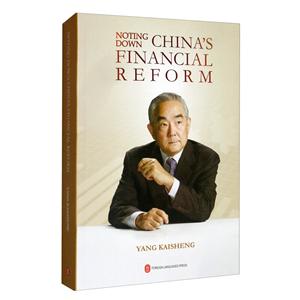-
>
以利為利:財政關系與地方政府行為
-
>
立足飯碗 藏糧于地——基于中國人均耕地警戒值的耕地保護視角
-
>
營銷管理
-
>
茶葉里的全球貿易史(精裝)
-
>
近代華商股票市場制度與實踐(1872—1937)
-
>
麥肯錫圖表工作法
-
>
海龜交易法則
Noting down Chinas financial reform(中國金融改革的探索與實踐——楊凱生金融筆記) 版權信息
- ISBN:9787119122915
- 條形碼:9787119122915 ; 978-7-119-12291-5
- 裝幀:一般膠版紙
- 冊數:暫無
- 重量:暫無
- 所屬分類:>
Noting down Chinas financial reform(中國金融改革的探索與實踐——楊凱生金融筆記) 內容簡介
Noting Down China's Financial Reform is a review and summary of the most important practices and major events in ttie reform and development of China's financial industry since the 1990's. A record of the process of China's firtaocial reform, it interpfets and ana;lyzes the reform principles and policies with a senior banker's insight ovef the past 20 years.
Noting down Chinas financial reform(中國金融改革的探索與實踐——楊凱生金融筆記) 目錄
Noting down Chinas financial reform(中國金融改革的探索與實踐——楊凱生金融筆記) 節選
《中國金融改革的探索與實踐:楊凱生金融筆記(英文)》: The asset recovery ratio notched up by the Chinese AMCs was no less than those of global models like the RTC and KAMCO.Notably, the high asset and cash recovery ratios were achieved against comparatively low asset quality. When the RTC acquired USD465 billion assets from nearly 1,000 S&Ls, only one-third of the assets were classifted as NPLs, and 92 percent of the NPLs had collaterals. In contrast, among the purchased assets of China's four AMCs, a large part of the bad debts (including de facto ones) were eligible for write-offs, yet remained on the banks' balance sheets due to all kinds of reasons, and the proportion stood at almost 40 percent. A closer feview of the collaterals showed that over 70 percent of the four AMCs' purchased assets belonged to credit loans, whereas the validity of the collaterals and guarantees of the remaining less than 30 pefcent of secured loans were still questionable. Given those scenarios, it was extremely tough for the AMCs to achieve such high recovery ratios, which should assure us of the promising future of China's fmancial AMCs. We must also un-derline the low operating cost. In 2000, the total financial expense of the four AMCs was around RMB1.48 billion, only 0.1 percent of the total distressed assets under their management, while the annual percentage of the RTC's financial expense on average was over 1 percent, a 1:10 ratio in comparable costs. In other words,the Chinese AMCs realized a higher return with less expense and effectively controlled the cost for handling legacy issues. 4. Promoting market-oriented resource allocation and econom-ic restructuring by mergers and acquisitions (M&As), asset reor-ganization, bankruptcy liquidation, etc. We firmly believe that dis-In the past two years, the four AMCs undertook distressed asset disposal with strong self-motivation to serve the bigger picture of economic restructuring. With a portfolio of measures such as asset sale, auction, call for bids, asset and debt restructuring, asset re-placement, and M&As, they restructUfed thousands of enterprises'on-balance-sheet assets worth tens of billions of renminbi. It even led to the reorganization of enterprises in different industries and regions and under different ownerships. For example, asset restructuring in building material and textile industries opumized their industrial organizations; the transfer of distressed assets to private capital and multinational corporations diversified the ownership structure of SOEs; the 300-odd M&As channeled useful resources to enterprises with competitive edge and enabled SOEs to grow bigger and stronger; through debt re-covery and bankruptcy liquidation, nearly 1,000 companies with poor management, irreversible losses, resource wastage or heavy pollution were phased out. The reforms in corporate governance also led to agreements on IPOs assistance, underwriting and spon-sorship with dozens of enterprises. In addition, the four AMCs helped more than 20 listed companies with their reorganization,which revitalized the companies, helped the securities market stay stable and safeguarded investors' interests.tressed assets should be viewed as a kind of misallocated resource. ……
Noting down Chinas financial reform(中國金融改革的探索與實踐——楊凱生金融筆記) 作者簡介
楊凱生,武漢大學經濟學院畢業,博士,研究員。現任中國銀行保險監督管理委員會靠前咨詢委員會委員。北京大學經濟學院兼職教授、中國政法大學兼職教授、中國人民銀行金融研究所博士生導師、北京大學互聯網金融研究中心特約不錯研究員。楊凱生曾任中國華融資產管理公司總裁,中國工商銀行副董事長、行長,工銀瑞信資產管理公司董事長、南非標準銀行副董事長。楊凱生是第十一屆、十二屆全國政協委員。
- >
伊索寓言-世界文學名著典藏-全譯本
- >
名家帶你讀魯迅:朝花夕拾
- >
姑媽的寶刀
- >
回憶愛瑪儂
- >
企鵝口袋書系列·偉大的思想20:論自然選擇(英漢雙語)
- >
人文閱讀與收藏·良友文學叢書:一天的工作
- >
龍榆生:詞曲概論/大家小書
- >
我與地壇
















